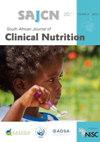在南非普马兰加省Kabokweni,对0–36个月大儿童的讲西斯瓦蒂语的母亲/照顾者进行南非儿童食品膳食指南修订草案的现场测试
IF 0.6
Q4 NUTRITION & DIETETICS
引用次数: 4
摘要
目的:确定0–36个月大儿童的西斯瓦蒂语母亲/照顾者对修订后的南非儿童食品膳食指南草案(SA-PFBDG)的适当性和理解程度。还评估了先前接触具有类似信息的指导方针、障碍和遵循指导方针的促成因素。设计:采用描述性、横断面的定性研究方法。采用目的抽样和滚雪球抽样的方法,共招募了75名参与者。数据是通过焦点小组讨论的方式从12个小组中收集的。背景:南非普马兰加的卡博克韦尼。受试者:研究人群包括提供知情同意书的18岁以上的母亲/照顾者。结果:与会者普遍意识到与SA-PFBDG修订草案中所载信息类似的信息。他们报告说,他们在诊所/医院、电台/电视台以及《健康之路》小册子中接触到了这些信息。参与者对母乳喂养、补充喂养、在幼儿饮食中加入富含蛋白质和淀粉的食物以及水果和蔬菜以及卫生习惯的指导方针有很好的理解。关于避免喝茶、咖啡和含糖饮料以及高糖、高脂肪的咸味零食、保持活跃和提供五顿小餐的指导方针还没有得到很好的理解。指导方针的重要性和对儿童健康的积极影响是指导方针得以实施的原因。障碍包括对指导方针的误解以及缺乏资金和资源。结论:修订后的SA PFBDG草案适用于0-36个月年龄组。建议进行一定程度的改写以帮助理解。该准则可作为改善南非儿童营养状况的教育工具。本文章由计算机程序翻译,如有差异,请以英文原文为准。
Field-testing of the revised, draft South African Paediatric Food-Based Dietary Guidelines among Siswati-speaking mothers/caregivers of children aged 0–36 months in Kabokweni, Mpumalanga province, South Africa
Objectives: To determine the appropriateness and understanding of the revised, draft South African Paediatric Food-Based Dietary Guidelines (SA-PFBDG) among siSwati speaking mothers/caregivers of children aged 0–36 months. Previous exposure to guidelines with similar messages, barriers and enablers to following the guidelines were also assessed. Design: A descriptive, cross-sectional qualitative research approach was followed. Purposive and snowball sampling were used to recruit a total of 75 participants. Data were collected by means of focus-group discussions from 12 groups. Setting: Kabokweni, Mpumalanga, South Africa. Subjects: The study population included mothers/caregivers older than 18 years who provided informed consent. Results: The participants were generally aware of messages similar to those contained in the revised, draft SA-PFBDG. They reported exposure to these messages at clinics/hospitals, radio/television, and the Road-to-Health booklet. Participants showed good understanding of guidelines on breastfeeding, complementary feeding, inclusion of protein-rich and starchy foods as well as fruit and vegetables in the diets of young children as well as hygiene practices. The guidelines on avoiding tea, coffee and sugar drinks and high-sugar, high-fat salty snacks, being active and providing five small meals were less well understood. Enablers to following the guidelines were its perceived importance and positive impact on children's health. Barriers included misinterpretation of the guidelines and lack of money and resources. Conclusion: The revised, draft SA-PFBDGs are appropriate for the age group 0–36 months. A degree of rewording is suggested to aid understanding. The guidelines can be used as an educational tool to improve the nutritional status of children in South Africa.
求助全文
通过发布文献求助,成功后即可免费获取论文全文。
去求助
来源期刊

South African Journal of Clinical Nutrition
NUTRITION & DIETETICS-
CiteScore
2.50
自引率
9.10%
发文量
21
期刊介绍:
1.The Journal accepts articles from all basic and applied areas of dietetics and human nutrition, including clinical nutrition, community nutrition, food science, food policy, food service management, nutrition policy and public health nutrition. 2.The Journal has a broad interpretation of the field of nutrition and recognizes that there are many factors that determine nutritional status and that need to be the subject of scientific investigation and reported in the Journal. 3.The Journal seeks to serve a broad readership and to provide information that will be useful to the scientific community, the academic community, government and non-government stakeholders in the nutrition field, policy makers and industry.
 求助内容:
求助内容: 应助结果提醒方式:
应助结果提醒方式:


